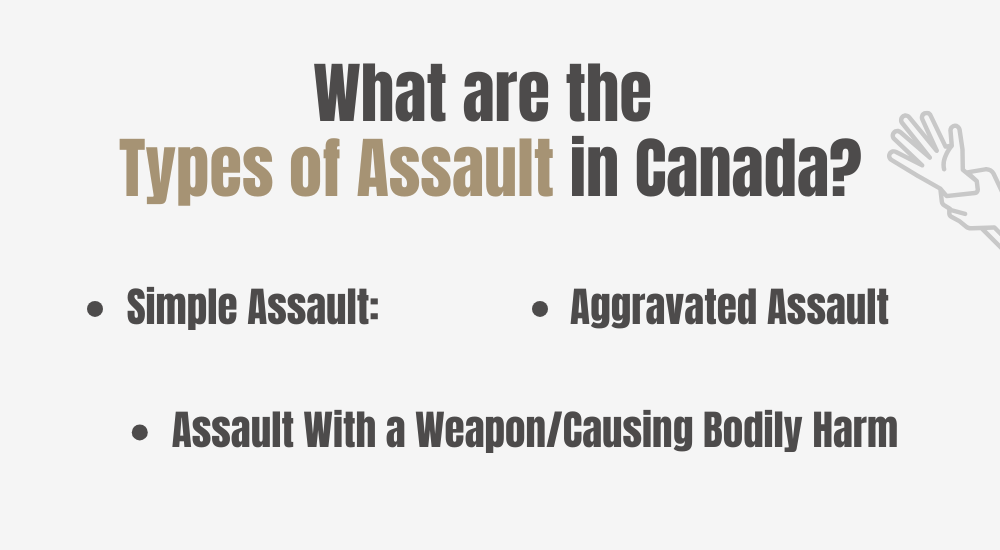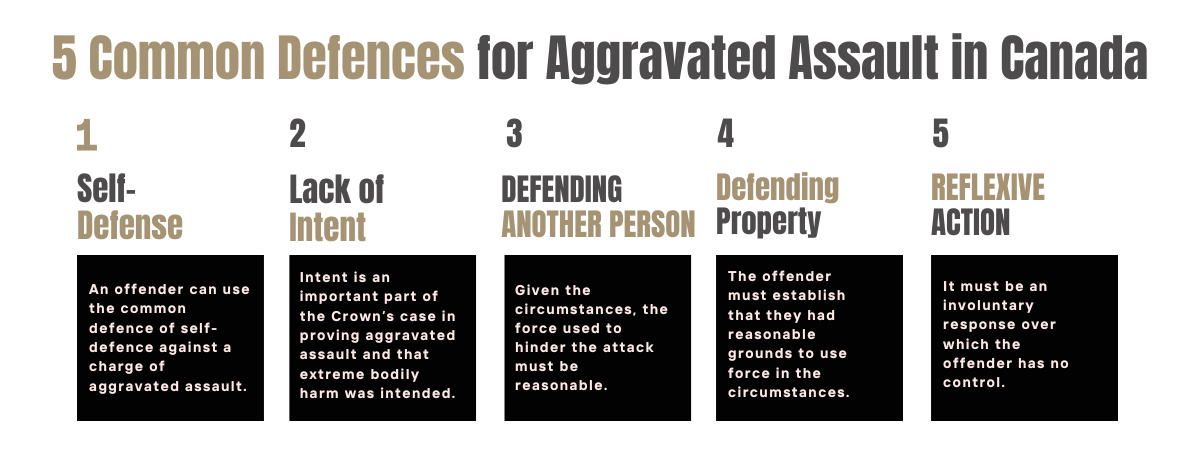Aggravated Assault in Canada: Explained in Simple Terms

Assault has varying degrees of charges in Canada, from simple assault to aggravated assault. Simple assault generally carries less harsher penalties than aggravated assault, and the latter can lead to severe consequences.
If you or someone you know has been charged with aggravated assault, and you would like to know more about it, then you have stumbled upon the right legal resource.
Our senior criminal lawyer in Mississauga has explained everything you’ll need to about assault ranging from its definition, what constitutes an aggravated assault and sentencing options.
What are the Types of Assault Offences in Canada?

The various types of assault offences in Canada include:
1) Simple Assault: Least serious offence and is ruled bySection 265 of the Criminal Code of Canada
2) Assault with a Weapon/Causing Bodily Harm: This is more serious than simple assault and are both found in Section 267 of the Criminal Code of Canada
3) Aggravated Assault: This is the most serious offence and is ruled by Section 268 of the Criminal Code of Canada
Simple assault and assault with a weapon/causing bodily harm are hybrid offences, and the Crown attorney can choose to proceed by indictment or summary conviction based on the seriousness of the offence.
However, aggravated assault is an indictable offence; we will discuss it in detail below.
What is Aggravated Assault?
Section 268 (1) of the Criminal Code of Canada sets out the criminal offence of aggravated assault, and is defined as:
“Everyone commits an aggravated assault who wounds, maims, disfigures or endangers the life” of a person.
To fall within the definition of aggravated assault, the offender must have committed this offence with the intent of inflicting serious harm, which includes wounding, maiming, or disfiguring of the complainant.
Objective foresight is also crucial in this case, as one has to prove that the offender knew that such conduct would cause serious injuries to the individual.
What Are the Elements of Aggravated Assault in Canada?
To expand on the aggravated assault meaning, it is crucial to understand the elements that constitute an offence as aggravated assault. For an offence to be an aggravated assault in Canada, there needs to be:
- Intent: The offence must have been committed with the intention and foreseeability of causing severe bodily harm to an individual.
- Force: The intentional application of force can be through direct or indirect means.
- Lack of consent: The assault must be without the consent of the complainant. Note, a mutual fight is not assault, however, one cannot consent to bodily harm.
- Objective foresight: The Crown attorney must prove beyond a reasonable doubt that the application of force was intentional and the offender knew that it would result in bodily harm.
- Serious injuries: The assault must lead to injuries of disfigurement, maiming, wounding, or endangering someone’s life
What are Serious Injuries for Aggravated Assault?
Disfigurement
Courts define disfigurement to mean injuries sustained by an individual that are more than temporary injuries and lead to disfiguring their appearance. This means that the harm leads to a permanent disability or scarring. For example, losing an arm can leave one permanently disabled, leaving lifelong scars.
Maiming
Maiming is a significant injury to a person that leaves them unable to defend themselves and function. Examples of this can include vision loss or shattered bones.
Wounding
While we count small cuts and scrapes as wounding, this will not fall under this. Instead, it refers to the cutting open or breaking of the person’s skin that requires immediate medical attention. Some permanent damage as a result of the aggravated assault is crucial for the harm to be considered wounding by the courts.
What are some Examples of Aggravated Assault in Canada?
It is crucial to understand the examples of aggravated assault set out by previous cases in Canada to know what falls under this category. Some of these include the following:
- Assault that resulted in serious physical injury to the other person
- Hitting another person with an object or weapon to break their bones
- Breaking and entering private property with a gun and firing at an individual leading to permanent damage
What are Defences to Aggravated Assault in Canada?
1. Self-Defence
An offender can use the common defence of self-defence against a charge of aggravated assault. If an offender opts for this defence strategy, then the following criteria should be considered:
- The offender must prove that the self-defence act was reasonable in the given circumstance;
- They reasonably believed that force was being used or a threat of force was being used against them or someone else;
- The offence was carried out with the purpose of defending themselves or someone else, and the alleged offender has to prove beyond a reasonable doubt that there was no other reasonable way of retreating or withdrawing from the harmful situation.
2. Lack of Intent
Intent is an important part of the Crown’s case in proving aggravated assault and that extreme bodily harm was intended.
Also, if aggravated assault occurred due to a reflexive reaction in the context of the situation, intent may be negated.
Proving lack of intention is a complex issue, and we recommend contacting our criminal defence lawyer in Mississauga to discuss it further.
3. Defending another Person
Canadian law also allows the application of force to defend other people. However, given the circumstances, the force used to hinder the attack must be reasonable. The offender will have to meet the same criteria for self-defence. They must prove that their actions to defend another person were reasonable and proportionate in the circumstances.
4. Defending Property
Defending one’s property is also a reasonable defence for aggravated assault. However, as with any other defence, the offender must establish that they had reasonable grounds to use force in the circumstances. If one were trying to remove someone from your property that led to the aggravated assault, then you may use this defence.
5. Reflexive Action
Finally, another common defence against aggravated assault is that it resulted from a reflexive action. This is a lack of voluntary conduct involved in the offence. However, for the action to be reflexive, it must be an involuntary response over which the offender has no control. The defence must also be realistic and in proportion to the circumstances at the time.
What are the Sentencing Options for Aggravated Assault?
Sentencing is ultimately determined by a judge after thorough review of the facts and circumstances of the case. Since aggravated assault is an indicatable offence, the maximum prison sentence is 14 years. Although a conditional sentence and a conditional discharge is not available for this offence, there are other options which a judge can impose. The following is a non-exhaustive list of options:
- Suspended Sentence
- Fine
- Fine and Probation
- Prison and Probation
- Prison and Fine
- Intermittent Sentence
- Fine, Probation and Intermittent Sentence
What are Sentencing Principles?
Sentencing is decided by a judge upon considering the following factors:
- The severity of injuries to victim
- Whether it was premeditated or a spontaneous act
- Criminal history of the offender
- Whether weapons were involved
- Victim impact statement
- Aggravating and mitigating factors
- The message to be sent to the community
FAQs
What is considered aggravated assault in Canada?
Hitting someone with or without the use of an object severe enough to cause extreme bodily harm.
What is the jail sentence for aggravated assault in Canada?
Although there are no minimum sentencing guidelines, the jail sentence for aggravated assault is a maximum of 14 years. However, there are options other than a jail sentence available for offenders.
Will I go to jail for on a first-time aggravated assault charge in Canada?
Aggravated assault is an indictable offence and is considered quite serious. The consequences Canada can range anywhere from fines to probation, mandatory counselling, a restraining order, or imprisonment up to 14 years. Each case is unique and is determined on its own merits upon review of the facts by an experienced criminal lawyer.
Contact a Criminal Defence Lawyer in Mississauga for Aggravated Assault
At Virk Barristers we have helped many clients charged with this offence. If you or someone you know has been charged with aggravated assault, you can get in touch with Suny Virk, a senior criminal defence lawyer in Mississauga for advice.
For more information, we recommend you contact us for a free consultation. We will understand the facts of your case and then create a solid strategy to secure the best possible defence.
Author Profile

- Mr. Suny Virk is a reputable criminal defence lawyer in Mississauga focusing primarily on criminal law matters of clients. Mr. Virk has been awarded with the Certificate of Merit Award in Advocacy. Now, he wants to impart his knowledge and wisdom to other people who may be struggling with the Canadian legal system to serve his community.
Latest entries
 UncategorizedMarch 25, 2025Cybercrime In Canada: How Criminal Law Handles Internet Offences
UncategorizedMarch 25, 2025Cybercrime In Canada: How Criminal Law Handles Internet Offences Legal AdviceMarch 7, 2025KNOW YOUR RIGHTS WHEN YOU ARE STOPPED BY THE POLICE
Legal AdviceMarch 7, 2025KNOW YOUR RIGHTS WHEN YOU ARE STOPPED BY THE POLICE Legal AdviceJanuary 24, 2025KNOW YOUR RIGHTS: 5 Things to Know When Getting Pulled Over by the Police
Legal AdviceJanuary 24, 2025KNOW YOUR RIGHTS: 5 Things to Know When Getting Pulled Over by the Police UncategorizedJanuary 11, 2025Ignition Interlock Ontario Program Explained by an Impaired Driving Lawyer in Ontario
UncategorizedJanuary 11, 2025Ignition Interlock Ontario Program Explained by an Impaired Driving Lawyer in Ontario






